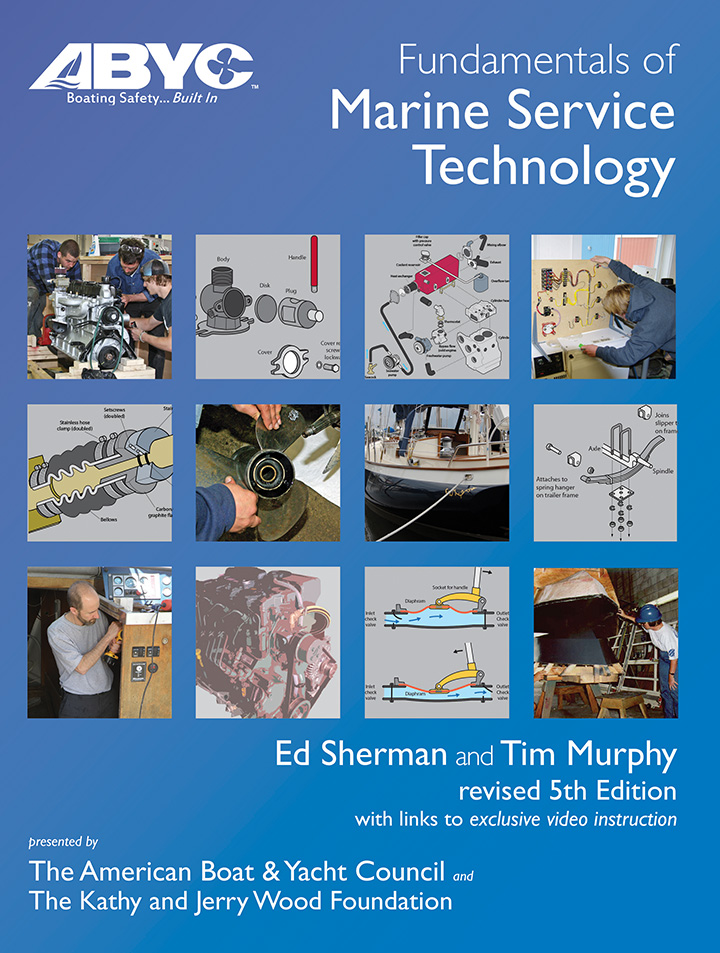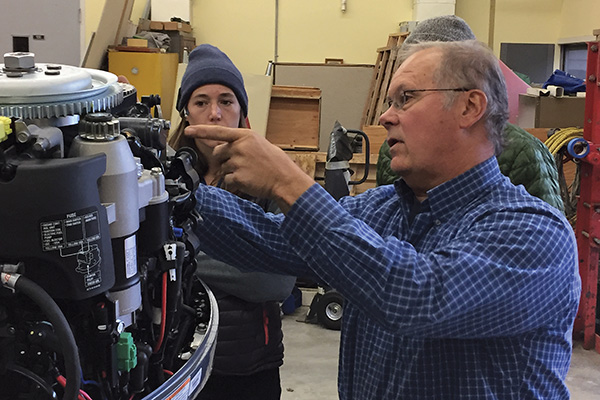Workforce: All for one and one for all

By Adam Quandt
Filling the workforce ranks has been an issue facing the recreational boating industry for quite some time and the problem is only growing larger. However, filling the open positions isn’t the only goal. The end goal is to fill those ranks with qualified employees who intend to stay in the industry.
According to data from the National Marine Manufacturers Association (NMMA), recreational boating supports 691,000 jobs across 35,000 U.S.-based marine businesses, yet there are currently 31,000 open jobs in the U.S. marine industry.
Many efforts to turn the tides of the industry’s workforce have already begun, but the group is simply just getting started.
Getting the conversation started
At the base level, leaders agree that conversations are needed industry-wide to bring more awareness to the problem.
NMMA’s Strategy 10+1: A Marine Industry Guide to Growing the Workforce offers instructive documents designed to help solve the issues facing the industry when it comes to workforce, by providing solution-based approaches and a variety of resources and strategic outlines.
“This isn’t just a workforce problem. It’s a customer service problem,” Marine Retailers Association of the Americas (MRAA) President Matt Gruhn and NMMA President Thom Dammrich remark in the guide’s opening letter. “If we can’t build the boats that we can sell and we can’t service the boats that we have already sold, boating will suffer.”
The guide is a supporting effort from major industry associations across the country.
During almost every industry conference attendees will find at least one, if not multiple sessions hoping to kick off the discussion on workforce. The International Boatbuilders’ Exhibition & Conference (IBEX) recently announced that it plans to host a “Super Session” in the conference’s 2019 educational lineup, covering challenges and solutions for workforce development.

The American Boat and Yacht Council (ABYC) has launched an entire conference simply dedicated to teaching the educators tasked with training a new generation of workforce. The inaugural Marine Service Technology: Educator Training Conference is scheduled to take place July 23-25 in Annapolis, Md.
The three-day conference will feature specific topics to enhance the knowledge, delivery and support of marine instructors and school administrators around the country.
“Whether you have been teaching marine tech for years, or are thinking about starting a marine tech program, this is a must attend event,” said ABYC vice president Ed Sherman. “Schools interested in a standards-based curriculum or trying to get more STEM into their shop class will learn how to do this painlessly, while networking and sharing ideas with other instructors.”
Team effort
Efforts to address the marine industry’s workforce issue are not going to come easy, nor will they come from a single source.
“Because the issue and the need is so great, this is an all hands on deck approach,” BRP Marine Group President Tracy Crocker said. “If you start looking at the trajectory of the industry and growth continues, it’s only going to become a bigger issue if we don’t all come together and coordinate a way of getting trained, qualified technicians out into the market place.”
Sherman and ABYC are calling upon manufacturers specifically to continue working toward workforce solutions in partnership with other industry members and associations.
“It’s our fault as an industry,” Sherman said. “As an industry the employers need to go to local schools and get aggressive and show that our industry is an option — not just a seasonal job, with poor pay scales, etc. Young people don’t even know we exist as an industry.”

Most recently, BRP Evinrude teamed up with ABYC by providing Evinrude training curriculum to be included in ABYC’s training manuals. In addition, Evinrude donated $2 million worth of new ETEC G2 outboard engines to the ABYC Foundation for training support.
“It was time for us to step up in the industry and put our money where our mouth is,” Crocker said. “However, our effort is not about an effort for Evinrude or just BRP, our effort is about the industry as a whole.”
ABYC’s program was built to help schools easily implement a standards-based marine service curriculum, with inland or coastal test options. Participating schools receive a textbook, instructor guides, PowerPoint presentations, online demonstration videos, test/quiz samples, and more.
There are currently 16 schools enrolled in using ABYC’s “Marine Service Technology” curriculum ranging from technical high schools to various college’s around the nation.
“Our partnership with ABYC is key to the success of Palm Beach State College’s new Marine Service Technology program,” said Eligio Marquez Jr., Palm Beach State College, transportation technology program director. “By integrating ABYC’s industry standards-based curriculum with our Florida state framework, we’ll be able to offer best possible program to our students, the future marine technicians Palm Beach County greatly needs.
Sherman said that it is important for the industry’s associations, like ABYC, to monitor what is going on with employers and the relationships between schools and employers when it comes to training and apprenticeships. “The thing about apprenticeships that I’ve learned is that it works best if it’s handled and managed locally by the school system, because they all have regional issues that are pretty specific and need to be addressed,” he added.
Similarly, Yamaha Marine collaborated with Steve Arnold — owner of Yarmouth Boat Yard, Moose Landing Marina and Freedom Boat Club of Maine — and Southern Maine Community College in South Portland, Maine to create a grant-funded extensive Yamaha outboard motor repair-training program. The grant allows SMCC to offer the training free of charge for qualified students.
“Qualified marine mechanics are a scarce resource. So, we decided to tackle the issue head on. We’ve had a strong business relationship with Yamaha for years, and as a Board Member for Maine Marine Trades Association, it made sense to bring these two great organizations together to help create a program that would attract and train certified marine technicians,” Arnold explained.
“The marine service industry is in need of many different positions, but qualified and quality technicians are in the highest demand,” added Joe Maniscalco, Yamaha Marine Service Division Manager. “Steve Arnold leveraged the resources Yamaha Marine has to offer and took them to the next level with the development of this course at SMCC. We encourage all dealers to leverage relationships with local technical schools as a means of recruiting the next generation of marine technicians.”
Yamaha Marine currently has more than 75 technical school partners nationwide for which the manufacturer works to provide current, market-relevant resources, products, certifications and curriculum for prospective marine technicians.
NMMA has also turned some more of its efforts toward workforce development in the form of various opportunities for its members.
To start, at the end of June, the NMMA is taking part at an annual conference for school guidance counselors, the ASCA Annual Conference. The objective is to market the boating industry as a career option to the next generation of workers through a program titled “Choose Your Workspace: Explore Careers in the Boating Industry.” The conference will attract over 2,500 school guidance counselors from throughout the U.S. (K-12 and some college level).
On the legislative front, NMMA has been closely monitoring and lobbying for funding to increase workforce programs.
The House Appropriations Committee released its proposed Fiscal Year 2020 (FY20) Labor, Health and Human Services, Education, and Related Agencies (LHHS) funding bill, which would bolster workforce development initiatives. Securing robust funding for the Department of Labor’s workforce programs to help address the recreational boating industry’s shortfall of qualified workers.
The proposed bill would allocate $13.3 billion for the Labor Department, including $10.6 billion for the Employment Training Administration (ETA). The ETA provides workforce assistance through grants, apprenticeship programs, and other job training initiatives. The bill includes $250 million for apprenticeship programs—a 56 percent increase above current levels—and $3 billion for workforce training grants.
“Our industry is really starting to wake up to the issue of its workforce, but there is certainly need for more of a team effort all around,” Sherman said.
While there may not be a single solution to the workforce issue, industry leaders from manufacturers to dealers and distributors to associations agree that it has to be an all in effort across the board to turn things around.
“It’s in all of our best interests,” Crocker said. “We have to attract and retain boaters all around and we simply cannot do that without a strong manufacturing workforce. The sooner we build that force collectively, the better.”




